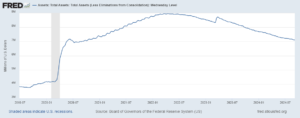
Quantitative tightening (QT) is a monetary policy tool used by central banks to reduce the money supply in an economy. It’s essentially the opposite of quantitative easing (QE), where central banks inject money into the economy by purchasing government bonds and other assets.
How Does QT Work?
- Selling Assets: Central banks sell the government bonds and other assets they acquired during QE, reducing their balance sheets.
- Decreasing Money Supply: When these assets are sold, the money used to purchase them is removed from circulation, reducing the overall money supply.
- Rising Interest Rates: As the money supply decreases, demand for loans increases, driving up interest rates.
The Role of Government Debt
Government debt plays a crucial role in QT. When a central bank purchases government bonds, it’s essentially lending money to the government. During QT, selling these bonds back to the market reduces the government’s debt. However, excessive government debt can create challenges for QT, as it may lead to higher interest rates and increased borrowing costs.
Central Banks Implementing Quantitative Tightening
As of 2023, several major central banks have been implementing quantitative tightening (QT) to combat inflation.
This policy involves reducing the size of their balance sheets by selling off assets, primarily government bonds, which effectively reduces the money supply in the economy.
Here are some key central banks that have been engaged in QT:
- Federal Reserve (U.S.): The Fed began its QT program in 2017, gradually reducing its balance sheet.
- Bank of England (UK): The BoE started its QT process in 2022, focusing on allowing existing bond holdings to mature without reinvestment.
- European Central Bank (ECB): The ECB initiated its QT program in 2022, gradually reducing its asset purchases.
The Bond Market
The bond market is a vital component of QT. When central banks sell government bonds, they enter the market as sellers, potentially increasing the supply of bonds and driving down their prices. This, in turn, can lead to higher interest rates. The bond market’s reaction to QT can significantly impact the overall economy.
Impact of Interest Rates on the Economy
Interest rates play a significant role in shaping economic activity. Higher interest rates can:
- Discourage borrowing and spending: As borrowing becomes more expensive, consumers and businesses may reduce their spending.
- Slow economic growth: Reduced spending can lead to slower economic growth as businesses may invest less and hire fewer workers.
- Impact inflation: Higher interest rates can help curb inflation by reducing demand for goods and services.
Conclusion
Quantitative tightening is a powerful tool that central banks can use to influence the economy. By reducing the money supply and raising interest rates, QT can help combat inflation and stabilize economic conditions. However, it’s important to use QT judiciously, as it can also have unintended consequences, such as slowing economic growth.
Quantitative tightening (QT), a monetary policy tool used by central banks to reduce the money supply, can have significant ripple effects across various sectors of the economy. Here’s a breakdown of how QT can impact different sectors:
1. Financial Markets:
- Bond Market: As central banks sell government bonds, the supply of these bonds increases, potentially driving down their prices and pushing up interest rates. This can hurt the bond market, particularly for long-term bonds.
- Stock Market: QT can lead to increased borrowing costs for businesses, which may negatively impact corporate profits and stock prices. Additionally, the rising interest rates can make it more expensive for investors to borrow money to purchase stocks, potentially dampening demand.
2. Housing Market:
- Mortgage Rates: Higher interest rates resulting from QT can make it more expensive to obtain a mortgage, which can reduce demand for housing. This can lead to a slowdown in the housing market, with potential declines in home prices.
- Home Affordability: Rising mortgage rates can significantly reduce home affordability, making it more difficult for potential homebuyers to enter the market. This can exacerbate housing affordability issues in certain regions.
3. Business Investment:
- Cost of Capital: QT can increase the cost of capital for businesses, making it more expensive to borrow money for investments. This can discourage businesses from investing in new projects, which can hinder economic growth.
- Profitability: Higher interest rates can reduce business profitability, as increased borrowing costs can eat into margins. This can lead to a slowdown in business activity and job growth.
4. Consumer Spending:
- Interest Rates on Credit Cards: QT can lead to higher interest rates on credit cards, making it more expensive for consumers to carry debt. This can reduce consumer spending power and slow economic growth.
- Cost of Living: Rising interest rates can increase the cost of living, as the interest on loans for cars, appliances, and other goods can rise. This can put a strain on household budgets and reduce consumer spending.
5. Inflation:
- Curbing Inflation: QT can help to curb inflation by reducing the money supply and slowing down economic activity. However, if QT is implemented too aggressively, it can lead to a recession.
- Balancing Act: Central banks must carefully balance the need to control inflation with the risk of economic slowdown when implementing QT.
6. Currency Markets:
- Exchange Rates: QT can strengthen a country’s currency relative to other currencies. This can make exports more expensive and imports cheaper, which can impact trade balances.
7. Emerging Markets:
- Capital Outflows: QT can lead to capital outflows from emerging markets as investors seek higher returns in developed economies with rising interest rates. This can put pressure on emerging market currencies and increase their borrowing costs.
8. Government Debt:
- Interest Payments: QT can increase the interest payments on government debt, which can put a strain on government finances. This can lead to increased government spending or tax hikes to balance the budget.
9. Economic Growth:
- Slowdown: QT can slow down economic growth, as it can reduce investment, consumer spending, and business activity.
- Recession Risk: If QT is implemented too aggressively, it can increase the risk of a recession.
10. Job Market:
- Job Losses: A slowdown in economic activity due to QT can lead to job losses, as businesses may reduce their workforce to cut costs.
It’s important to note that the impact of QT can vary depending on the specific economic conditions and the central bank’s implementation. Additionally, the effects of QT can be influenced by other factors, such as fiscal policy and global economic trends.
References:
- Federal Reserve Bank of St. Louis: https://www.investopedia.com/quantitative-tightening-6361478
- The New York Times: https://www.investopedia.com/quantitative-tightening-6361478
- Investopedia: https://www.investopedia.com/quantitative-tightening-6361478


